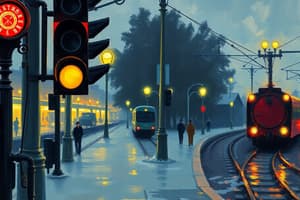Podcast
Questions and Answers
What is the primary purpose of Fixed Signals in rail traffic regulation?
What is the primary purpose of Fixed Signals in rail traffic regulation?
- They provide entertainment for passengers.
- They are used to control train speeds.
- They separate and regulate rail traffic. (correct)
- They indicate the weather conditions.
Where are Fixed Signals typically positioned for optimal visibility?
Where are Fixed Signals typically positioned for optimal visibility?
- At a distance of 100 meters from the crossing.
- On the right-hand side of the track only.
- At the station's main entrance.
- On the left-hand side of the track, or as required. (correct)
Which type of signal uses a colored arm to display aspects during the day?
Which type of signal uses a colored arm to display aspects during the day?
- Disc Signals
- Semaphore Signals (correct)
- Light Signals
- Automatic Signals
What classification of Fixed Signals is designated for signaling at low speeds and for calling on trains?
What classification of Fixed Signals is designated for signaling at low speeds and for calling on trains?
What do Disc Signals display during the day?
What do Disc Signals display during the day?
Which signals are intended to indicate the status of the line ahead to train crews?
Which signals are intended to indicate the status of the line ahead to train crews?
What determines the classification of Fixed Signals?
What determines the classification of Fixed Signals?
What is a common feature of Light Signals?
What is a common feature of Light Signals?
What does the Calling on signal look like in its normal position?
What does the Calling on signal look like in its normal position?
When should co-acting signals be read as one signal?
When should co-acting signals be read as one signal?
What happens if both signals show a proceed aspect?
What happens if both signals show a proceed aspect?
In the case of multiple signals on one post with only one co-acting arm or light, which signal applies?
In the case of multiple signals on one post with only one co-acting arm or light, which signal applies?
What is a critical consideration if conflicting aspects are displayed on co-acting signals?
What is a critical consideration if conflicting aspects are displayed on co-acting signals?
Which feature is true for Two Position Automatic Signals?
Which feature is true for Two Position Automatic Signals?
When are signals with a horizontal arm considered to be displaying a proceed aspect?
When are signals with a horizontal arm considered to be displaying a proceed aspect?
What defines the role of Co-acting Signals in relation to visibility?
What defines the role of Co-acting Signals in relation to visibility?
What should a driver do after passing a 'Reduce to Medium Speed' signal if the next signal shows an improved aspect?
What should a driver do after passing a 'Reduce to Medium Speed' signal if the next signal shows an improved aspect?
What does the 'Low Speed Caution' signal indicate?
What does the 'Low Speed Caution' signal indicate?
What speed must not be exceeded when a 'Low Speed Caution' signal is displayed?
What speed must not be exceeded when a 'Low Speed Caution' signal is displayed?
When should a driver treat a signal as defective?
When should a driver treat a signal as defective?
Who must be informed if a defective signal cannot be secured at stop?
Who must be informed if a defective signal cannot be secured at stop?
What safety action should be taken if a signal is found to have multiple signals to proceed?
What safety action should be taken if a signal is found to have multiple signals to proceed?
What is the responsibility of the Signaller/Train Controller when encountering a defective signal?
What is the responsibility of the Signaller/Train Controller when encountering a defective signal?
What should a driver be prepared for when the 'Low Speed Caution' signal is displayed?
What should a driver be prepared for when the 'Low Speed Caution' signal is displayed?
Flashcards are hidden until you start studying
Study Notes
Calling On Signal
- Consists of a short arm under the Home signal and applies to the same line as the Home signal
- In the normal position, the light is obscured and the arm is horizontal
- In the proceed position, the yellow light is visible or the arm is at 45 degrees below horizontal
- Should both signals show a proceed aspect, then the signals must be considered to be at stop due to conflicting aspects
Co-Acting Signals
- Used when a signal cannot be easily seen due to obstructions
- Both signal arms or lights are read as a single signal
- Can be placed on the same post with one signal higher or lower than the other
- Can also be placed on separate posts but must not be read as separate signals
- If conflicting aspects are displayed, both signals must be considered to be at the safest position
- If there are two or more signals on the same post with only one co-acting arm or light, then the top signal applies to the co-acting arm or light
Two Position Automatic Signals
- Use coloured lights to indicate Stop or Proceed
- When “Reduce to Medium Speed” is displayed, the driver may proceed at normal speed but must reduce to medium speed (40 km/h) before the next signal
- If after passing “Reduce to Medium Speed” the driver observes the next signal is displaying an improved aspect such as normal speed, the driver may regulate the speed to the aspect of that signal
- LOW SPEED CAUTION – (RED over RED over YELLOW)
- Indicated by a yellow light below two red lights
- Indicates the points are set in the correct position for the driver to proceed but does not indicate the line is unoccupied
- Driver must be prepared to stop short of any obstruction
- The speed of the train must not exceed 15 km/h
Defective Signals
- The Safeworking Manager must be informed when the defective signal cannot be secured at Stop or the most restrictive aspect
- The Signaller/Train Controller must apply Blocking Facilities to prevent rail traffic from approaching the defective signal until authorised by the Safeworking Manager
- The Safeworking Manager will determine any additional safety measures required for the safe operation of trains
Incorrectly Displayed Signals
- Must be considered as defective and treated at their most restrictive aspect when:
- The absence of a signal when usually present
- A signal aspect imperfectly displayed
- Presence of a light where a red, purple, green or yellow light should be shown
- Exhibition of two signals to proceed where only one such signal should be displayed
Fixed Signals - Two Position
- Purpose of Fixed Signals is to regulate the movement of Rail Traffic on the rail network and are used to:
- Separate and regulate Rail Traffic
- Indicate to the train crews and other competent employees of the status of the line ahead
- Show which route is set
- Fixed Signals are located:
- Where they enable train crews to see and respond to in sufficient time to safely control the rail movement
- Where they provide a sufficient overlap
- And are normally positioned:
- On the left hand side of the track – (can be placed on the right hand side as required)
- Directly over the track to which they apply
Fixed Signals - Types
- There are three types of Fixed Signals in Operation on the V/Line Network:
- Semaphore Signals
- Light Signals
- Disc Signals
Fixed Signals - Classifications
- Fixed Signals are classified by the function performed and the location of the signal:
- Distant and Repeating Signals
- Home Signals
- Automatic Signals
- Calling On and Low Speed Signals
Studying That Suits You
Use AI to generate personalized quizzes and flashcards to suit your learning preferences.



